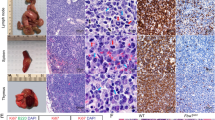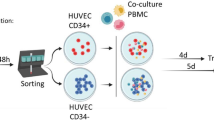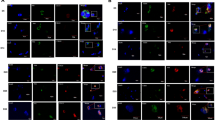Abstract
Human immunodeficiency virus (HIV)-I infection is associated with the development of aggressive extranodal B-cell non-Hodgkin's lymphomas. Using microvascular endothelial cell (MVEC)-enriched bone marrow stromal cultures, HIV infection of stromal MVECs from lymphoma patients induced the outgrowth of malignant B cells. MVECs were the only HIV-infected cells in the stroma, and purified brain MVECs also induced a phenotype supportive of neoplastic B-cell attachment and proliferation. HIV infection of MVECs stimulated surface expression of CD40 and allowed preferential induction of the vascular cell adhesion molecule VCAM-1 after CD40 triggering. B-lymphoma cells expressed the CD40 ligand (CD40L), and blocking of CD40–CD40L interactions between HIV-infected MVECs and B-lymphoma cells inhibited B-cell attachment and proliferation. These observations suggest that HIV promotes B-lymphoma cell growth through facilitating attachment of lymphoma cells to HIV-infected MVECs and represent a novel mechanism through which viruses may induce malignancies.
This is a preview of subscription content, access via your institution
Access options
Subscribe to this journal
Receive 12 print issues and online access
$209.00 per year
only $17.42 per issue
Buy this article
- Purchase on Springer Link
- Instant access to full article PDF
Prices may be subject to local taxes which are calculated during checkout
Similar content being viewed by others
References
Gaidano, G. & Dalla-Favera, A. Molecular pathogenesis of AIDS-related lym-phomas. Adv. Cancer Research 67, 113–153 (1995).
Beral, V., Peterman, T., Berkelman, R. & Jafe, H. AIDS-associated non-Hodgkin lymphoma. Lancet 337, 805–809 (1991).
Shiramizu, B., Herndier, B., Meeker, T. & McGrath, M. Molecular and immunophe-notypic characterization of AIDS-associated, Epstein-Barr virus-negative, polyclonal lymphoma. J. Clin. Oncol. 10, 383–389 (1992).
Delecluse, H. et al. Variable morphology of human immunodeficiency virus-associated lymphomas with c-myc rearrangements. Blood 82, 552–563 (1993).
Astrin, S.M., Schattner, E., Laurence, J., Lebman, R.I. & Rodriguez-Alfageme, C. Does HIV infection of B lymphocytes initiate AIDS lymphoma? Detection by PCR of viral sequences in lymphoma tissue. Cur. Top. Microbiol. Immunol. 182, 399–407 (1992).
Prevot, S., Raphael, M., Fournier, J.G. & Diebold, J. Detection by in situ hybridization of HIV and c-myc RNA in tumor cells of AIDS-related B-cell lymphomas. Histopathology 22, 151–156 (1993).
Groopman, J.E. et al. Pathogenesis of B cell lymphoma in a patient with AIDS. Blood 67, 612–615 (1986).
Pellici, G. et al. Multiple monoclonal B-cell expansions and c-myc oncogene re arrangements in acquired immune deficiency syndrome related lymphoproliferative disorders: Implications for lymphomagenesis. J. Exp. Med. 164, 2049–2076 (1986).
Subar, M., Neri, A., Inghirami, C., Knowles, D.M. & Dalla-Favera, R. Frequent c-myc oncogene activation and infrequent presence of Epstein-Barr virus genome in AIDS-associated lymphoma. Blood 72, 667–671 (1988).
Caidano, G. et al. In vitro establishment of AIDS-related lymphoma Cell lines: Phenotypic characterization, oncogene and tumour suppressor gene lesions, and heterogeneity in Epstein-Barr virus infection. Leukemia 7, 1621 1629 (1993).
Jacobsen, K. & Osmond, D.G. Microenvironmental organization and stromal cell associations of B lymphocyte precursor cells in mouse bone marrow. Eur. J. Immunol. 20, 2395–2398 (1990).
Wolf, M.L., Buckley, J.A., Goldfarb, A., Law, C.L. & LeBien, T.W. Development of a bone marrow culture for maintenance and growth of normal human B-cell precursors. J. Immunol. 147, 3324–3330 (1991).
Larvis, L.J. & LeBien, T.W. Stimulation of human bone marrow stromal cell tyrosine kinases and IL-6 production by contact with B lymphocytes. J. Immunol. 155, 2359–2368 (1995).
Campana, D. et al. Prolonged survival of B-lineage acute lymphoblastic leukemia cells is accompanied by overexpression of bcl-2 protein. Blood 81, 1025–1031 (1993).
Freedman, A.S. Expression and function of adhesion receptors on normal B-cells and B-cell non-Hodgkin's lymphomas. Semin. Hematology 30, 318–328 (1993).
Manabe, A. et al. Adhesion-dependent survival of normal and leukemic human B lymphoblasts on bone marrow stromal cells. Blood 83, 758–766 (1994).
Panayiotidis, P., Jones, D., Ganeshaguru, K., Foreni, L. & Hoffbrand, A.V. Human bone marrow stromal cells prevent apoptosis and support the survival of chronic lymphocytic leukaemia cells in vitro. Br. J. Haematol. 92, 97–103 (1996).
Dittel, B.N., McCarthy, J., Wayner, E.A. & LeBien, T.W. Regulation of human B-cell precursor adhesion to bone marrow stromal cells by cytokines that exert opposing effects on the expression of vascular cell adhesion molecule-1 (VCAM-1). Blood 81, 2272–2282 (1993).
Moses, A.V. et al. HIV infection of bone marrow endothelium reduces induction of stromal hematopoietic growth factors. Blood 87, 919–925 (1996).
Kellog, D.E. & Kwok, S. Detection of human immunodeficiency virus. in PCR Protocols: A Guide to Methods and Applications. (eds. Innes, M.A., Gelfand, D.H., Sninsky, J.J. & White, T.J.) 337–347 (Academic Press, New York, 1990).
Telenti, A., Marshall, W.F. & Smith, T.F. Detection of Epstein-Barr virus by poly-merase chain reaction. J. Clin. Microbiol. 28, 2187–2190 (1990).
Moore, P.S. & Chang, Y. Detection of herpesvirus-like DNA sequences in Kaposi's sarcoma in patients with and without HIV infection. N. Engl. J. Med. 332, 1181–1185 (1995).
Moses, A.V., Bloom, F.E., Pauza, C.D. & Nelson, J.A. Human immunodeficiency virus infection of human brain capillary endothelial cells occurs via a CD4/galactosylce-ramide-independent mechanism. Proc. Notl. Acad. Sci. USA 90, 10474–10478 (1993).
Moses, A.V. et al. Sequences regulating tropism of HIV-1 for brain capillary endothelial cells map to a unique region on the viral genome. J. Virol. 70, 3401–3406 (1996).
Ryan, D.H., Nucci, B.L., Abbound, C.N. & Winslow, J.M. Cell adhesion molecule-1 and the integrin VLA-4 mediate adhesion of human B-Cell precursors to cultured bone marrow adherent Cells. J. Clin. Invest. 88, 995–1004 (1991).
Freedman, A.S. et al. Follicular non-Hodgkin's lymphoma cell adhesion to normal germinal centers and neoplastic follicles involves very late antigen-4 and vascular cell adhesion molecule-1. Blood 79, 206–212 (1992).
Simmonds, P.J. et al. Vascular cell adhesion molecule-1 expressed by bone marrow stromal cells mediates the binding of hematopoietic progenitor cells. Blood 80, 388–395 (1992).
Tang, J., Scott, G. & Ryan, D.H. Subpopulations of bone marrow fibroblasts support VLA-4-mediated migration of B-cell precursors. Blood 82, 3415–3423 (1993).
Moses, A.V., Stenglein, S.C. & Nelson, J.A. HIV infection of the brain microvascula-ture and its contribution to the AIDS dementia complex. J. NeuroAIDS 1, 85–99 (1996).
Wong, D. & Dorovtni-Zis, K. Expression of vascular cell adhesion molecuie-1 (VCAM-1) by human brain microvessel endothelial cells in primary culture. Microvasc. Res. 49, 325–339 (1995).
Hollenbaugh, D. et al. Expression of functional CD40 by vascular endothelial cells. J. Exp. Med. 182, 33–4O (1995).
Karmann, K., Hughes, C.C.W., Schechner, J., Fanslow, W.C. & Pober, J.S. CD40 on human endothelial cells: inducibility by cytokines and functional regulation of adhesion molecule expression. Proc. Notl. Acad. Sci. USA 92, 4342–4346 (1995).
Yellin, M.J. et al. Functional interactions of T cells with endothelial cells: The role of CD40L-CD40-mediated signals. J. Exp. Med. 182, 1857–1864 (1995).
Yellin, M.J. et al. Ligation of CD40 on fibroblasts induces CD54 (ICAM-1) and CD106 (VCAM-1) up-regulation and IL-6 production and proliferation. J. Leukocyte Biol. 58, 209–216 (1995).
Graf, D., Korthauer, U., Mages, H.W., Senger, G. & Kroczek, R.A. Cloning of TRAP, a ligand for CD40 on human T cells. Eur. J. Immunol. 22, 3191- (1992).
Pinchuk, L.M. et al. Functional CD40 ligand expressed by human blood dendritic cells is up-regulated by CD40 ligation. J. Immunol. 157, 4363–4370 (1996).
Mach, F. et al. Functional CD40 ligand is expressed on human vascular endothelial cells, smooth muscle cells, smooth muscle cells, and macrophages: Implications for CD40-CD40L signalling in atherosclerosis. Proc. Notl. Acad. Sci. USA 94, 1931–1936 (1997).
Crammer, A.C. et al. The CD40 Ligand expressed by human B cells costimulates B cell responses. J. Immunol. 154, 4996–5010 (1995).
Castle, B.E. et al. Regulation of expression of the ligand for CD40 on T helper lymphocytes. J. Immunol. 151, 1777–1788 (1993).
Chang, H-K., Gallo, R.C. & Ensoli, B., Regulation of cellular gene expression and function by the human immunodeficiency virus type 1 tat protein. J. Biomed. Sci. 2, 189–202 (1995).
Harris, M. From negative factor to a critical role in viral pathogenesis: The changing fortunes of nef. J. Cen. Virol. 77, 2379–2392 (1996).
Cohen, E.A. et al. Identification of HIV-1 vpr product and function. J. Aquired Immune Defic. Syndr. 3, 11–18 (1990).
Wang, F. et al. Epstein-Barr virus latent membrane protein (LMP 1) and nuclear proteins 2 and 3c are effectors of phenotypic changes in B lymphocytes: EBNA 2 and LMP 1 cooperatively induce CD23. J. Virol. 64, 2309–2318 (1990).
Pammer, J. et al. CD40 antigen is expressed by endothelial cells and tumor cells in Kaposi's sarcoma. Am. J. Pathol. 148, 1387–1396 (1996).
Broshoff, C. et al. Kaposi's sarcoma-associated herpesvirus infects endothelial and spindle cells. Nature Med. 1, 1274–1278 (1995).
Gruss, H.-J. & Dower, S.K., Tumor necrosis factor ligand superfamily: Involvement in the pathology of malignant lymphomas. Blood 85, 3378–3404 (1995).
Wiley, C.A., Schrier, R.D., Nelson, J.A., Lampert, P.W. & Oldstone, M.B.A. Cellular localization of human immunodeficiency virus infection within the brains of acquired immunodeficiency patients. Proc. Notl. Acad. Sci. USA 83, 7089–7093 (1986).
Steffan, A-M. et al. Primary cultures of endothelial cells from the human liver sinusoid are permissive for human immunodeficiency virus type 1. Proc. Notl. Acad. Sci. USA 89, 1582–1586 (1992).
Green, D.F., Resnick, L. & Bourgoignie, J.J. HIV infects glomerular endothelial and mesangial but not epithelial cells in vitro. Kidney Int. 41, 956–960 (1992).
Rettig, M.B. et al. Kaposi's sarcoma-associated herpesvirus infection of bone marrow dendritic cells from multiple myeloma patients. Science 276, 1851–1854 (1997).
Gallo, R.C. et al. Frequent detection and isolation of cytopathic retroviruses (HTLV-III) from patients with AIDS and at risk for AIDS. Science 224, 500–503 (1984).
Cann, A.J. et al. Human immunodeficiency virus type 1 T-cell tropism is determined by events prior to provirus formation. J. Virol. 64, 4735–4742 (1990).
Levy, J.A. & Shimabukuro, J. Recovery of AIDS-associated retroviruses from patients with AIDS or AIDS-related conditions and from clinically healthy individuals. J. Infect. Dis. 152, 734–738 (1995).
Koyanagi, S. et al. Dual infection of the central nervous system by AIDS viruses with distinct cellular tropisms. Science 236, 819–836 (1987).
Cheng-Mayer, C., Weiss, C., Seto, D. & Levy, J.A. Isolates of human immunodeficiency virus type 1 from the brain may constitute a special group of the AIDS virus. Proc. Notl. Acad. Sci. USA 86, 8575–8579 (1989).
Author information
Authors and Affiliations
Rights and permissions
About this article
Cite this article
Moses, A., Williams, S., Strussenberg, J. et al. HIV-1 induction of CD40 on endothelial cells promotes the outgrowth of AIDS-associated B-cell lymphomas. Nat Med 3, 1242–1249 (1997). https://doi.org/10.1038/nm1197-1242
Received:
Accepted:
Issue Date:
DOI: https://doi.org/10.1038/nm1197-1242
This article is cited by
-
Flipping the switches: CD40 and CD45 modulation of microglial activation states in HIV associated dementia (HAD)
Molecular Neurodegeneration (2011)



